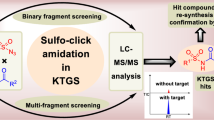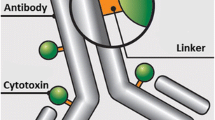Abstract
Synthesis and properties of a new fluorescent/fluorogenic substrate Ac-DEVD-AMAC for caspase-3 are reported. The substrate is obtained by conventional Fmoc-based solid phase peptide synthesis and its properties are investigated with regard to fluorescence, sensitivity, applicability and kinetic constants. A non-traditional approach to assay the proteases activity using 2-aminoacridone labeled peptides is proposed. This approach utilizes the decrease of fluorescence intensity of a sample as a measure for the enzyme activity.






Similar content being viewed by others
References
Baustert JH, Wolfbeis OS et al (1988) Fluorometric continuous kinetic assay of α-chymotrypsin using new protease substrates possessing long-wave excitation and emission maxima. Anal Biochem 171:393–397
Bleackley RC, Heibein JA (2001) Enzymatic control of apoptosis. Nat Prod Rep 18:431–440
Cai SX, Zhang H-Z et al (2001) Design and synthesis of Rhodamine 110 derivative and caspase-3 substrate for enzyme and cell-based fluorescent assay. Bioorg Med Chem Lett 11:39–42
Fan X, You J, Zhu et al (1998) New reagents for determination of amino acids by liquid chromatography with pre-column fluorescence derivatization. Anal Chim Acta 367:81–91
Fuentes-Prior P, Salvesen GS (2004) The protein structures that shape caspase activity, specificity, activation and inhibition. Biochem J 384:201–232
Garcia-Calvo M, Peterson EP et al (1999) Purification and catalytic properties of human caspase family members. Cell Death Differ 6:362–369
Gray CJ, Sullivan JM (1989) Synthesis of 7-amino-4-methylcoumarin (AMC) derivatives and their hydrolysis by plant cysteine proteinases. J Chem Tech Biotechnol 46:11–26
Gurtu V, Kain SR, Zhang G (1997) Fluorometric and colorimetric detection of caspase activity associated with apoptosis. Anal Biochem 251:98–102
Kaiser E, Colescot RL et al (1970) Color test for detection of free terminal amino groups in solid-phase synthesis of peptides. Anal Biochem 34:595–598
Lien S, Pastor R et al (2004) A substrate-phage approach for investigating caspase specificity. Protein J 23:413–425
Liu J, Bhalgat M et al (1999) Fluorescent molecular probes V: A sensitive caspase-3 substrate for fluorometric assays. Bioorg Med Chem Lett 9:3231–3236
Mizukamia S, Kikuchia K et al (1999) Imaging of caspase-3 activation in HeLa cells stimulated with etoposide using a novel fluorescent probe. FEBS Lett 453:356–360
Moser R (1989) New fluorogenic protease substrates possessing long-wave excitation and emission maxima. Appl Fluoresc Technol 1:15–16
O’Brien MA, Daily W et al (2005) Homogeneous, bioluminescent protease assays: Caspase-3 as a model. J Biomol Screen 10:137–148
Okafo GN, Burrow LM et al (1996) Simple differentiation between core-fucosylated and nonfucosylated glycans by capillary electrophoresis. Anal Biochem 240:68–74
Packard BZ, Toptygin DD et al (1997) Design of profluorescent protease substrates guided by exciton theory. Methods Enzymol 278:15–23
Smith RE, Bissell ER et al (1980) Direct photometric or fluorometric assay of proteinases using substrates containing 7-amino-4-trifluoromethylcoumarin. Thromb Res 17:393–402
Smith JA, West RM, Allen M (2004) Acridones and quinacridones: Novel fluorophoresfor fluorescence lifetime studies. J Fluorescence 14:151–171
Stennicke HR, Salvesen GS (2000) Caspase assayes. Methods Enzymol 322:91–100
Sun J, Bottomley SP et al (1997) Recombinant Caspase-3 expressed in Pichia pastoris is fully activated and kinetically indistinguishable from the native enzyme. Biochem Biophys Res Commun 238:920–924
Thornberry NA, Rano TA et al (1997) A combinatorial approach defines specificities of members of the caspase family and granzyme B. J Biol Chem 272:17907–17911
Wang Z-Q, Liao Jand Diwu Z (2005) N-DEVD-N′-morpholinecarbonyl-rhodamine 110 novel caspase-3 fluorogenic substrates for cell-based apoptosis assay. Bioorg Med Chem Lett 15:2335–2338
You J, Fan X et al (1999) High performance liquid chromatographic determination of N-nitrosoamines by pre-column fluorescence derivatization with acridone-N-acetyl chloride. Talanta 48:437–449
Acknowledgments
This study was financially supported by The National Science Fund of Bulgaria (Grand BYX-10/2005).
Author information
Authors and Affiliations
Corresponding author
Rights and permissions
About this article
Cite this article
Lozanov, V., Ivanov, I.P., Benkova, B. et al. Peptide substrate for caspase-3 with 2-aminoacridone as reporting group. Amino Acids 36, 581–586 (2009). https://doi.org/10.1007/s00726-008-0136-4
Received:
Accepted:
Published:
Issue Date:
DOI: https://doi.org/10.1007/s00726-008-0136-4




